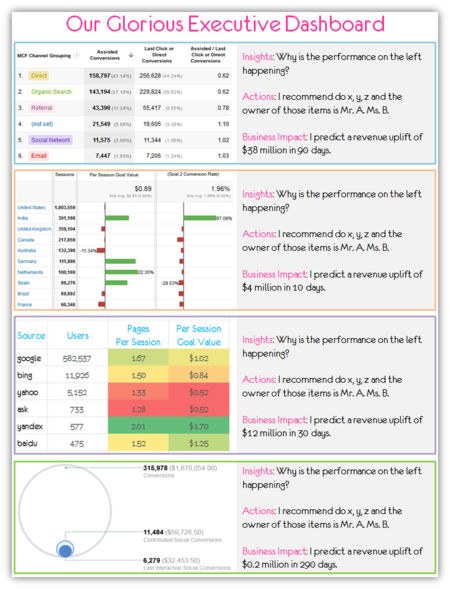- 91% of marketing leaders believe successful brands use customer data to drive business decisions (source: Columbia Business School/IAB)
- 87% agree capturing and sharing the right data is important to effectively measuring ROI in their own company (Columbia Business School/IAB)
- Organizations driven by data-based decision making have 4% higher productivity rates and 6% higher profits (MIT Center for Digital Business)
Data and algorithms have a tendency to outperform human intuition. As a result, companies are vacuuming up data to make better decisions about everything from product development, marketing, advertising to hiring.
But it’s not the data, it’s what you do with it. Because data doesn’t make decisions, people do. Insights and actions are as important as statistical analysis.
Here are 9 non-technical steps to better data-driven decision making.
- UNDERSTAND THE REAL BUSINESS QUESTIONS: Ask key stakeholders who will be making decision from the data: “What are the question you want the data to answer? What’s the context and who are the impacted segments?”
- PICK THE RIGHT METRICS: There is a difference between numbers and numbers that matter. Good metrics are consistent, cheap, and quick to collect. They have to capture capture what your business cares most about.
- ASK THE RIGHT QUESTIONS OF THE DATA: Managers have a critical role to play framing questions before the analysis before the analysis begins. What is the source of the data? How well does the data represent the population or the audience that is most important for the analysis?
- CENTRALIZE WHERE DATA RESIDES: A firm needs to take inventory of its key data properties, as well as identify the specific business needs and functions. A critical success factor is a proper data architecture and pairing of data within a business function for impacts and inter-dependencies.
- PROCESS TRUMPS TECHNOLOGY: Data-driving decision making involves gathering, analyzing, reporting and taking action. It’s a that happens to happen regularly and involve a team of people who have specific functions to be effective.
- IT’S GOING TO COST MORE MONEY AND TIME: The process itself demands a serious commitment to training, data cleanup, and maintenance. End users have to trained on tools, how to use data for analysis, how the data is structured and what is data-warehouse security.
- KNOW THE BASICS OF DATA VISUALIZATION: For data to tell a story, it has to be visualized effectively. Before considering the technique or software for data visualization, look at who is the audience for the analysis; how much do you want to show them to convince them of the insights, actions and financial implications to be taking from the data
- CORRELATION IS NOT CAUSE AND EFFECT: Just because a correlation exists doesn’t mean there is a cause and effect. The frequency and length of time for the correlation plays a big role. This minimizes the risk of taking or not taking action, but never ensures cause and effect and the benefits of being right or wrong.
- DISCOVER INSIGHTS, MAKE RECOMMENDATIONS AND TAKE ACTIONS: Reporting is not analysis and analysis is not results. To get to productivity and profitability rates cited above, data-driven decision can’t happen without insights, recommendation and actions taking all along the way.
Do these steps help you understand how to achieve data-driven results? Does your company operate this way? Are you ready to begin?

